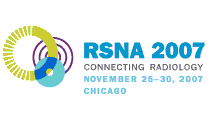
Abstract Archives of the RSNA, 2007
Se Yeong Chung MD, Presenter: Nothing to Disclose
Woo Kyung Moon MD, Abstract Co-Author: Nothing to Disclose
Nariya Cho MD, Abstract Co-Author: Nothing to Disclose
To determine the outcome of ultrasound (US) detected nonpalpable breast lesions prospectively categorized as BIRADS 2, 3, 4, and 5.
Between Jan 1, 2004 and Dec 31st, 2004, 4237 women underwent both screening mammography and bilateral whole breast US using a 12 or 13 MHz transducer. All US examinations were performed by one of five radiologists and final assessment categories of BIRADS 2, 3, 4(a, b, c), and 5 were provided prospectively for US-detected nonpalpable breast lesions. Of 1898 breast US exams interpreted as BIRADS 2-5, 409 were excluded due to BIRADS reflecting mammographic interpretation. The study included 1489 breast examinations in 1467 women (mean age, 50 years).
Of 1112 BIRADS 2 lesions, biopsy of 10 (0.9%) lesions were all confirmed as benign (100%). On imaging follow-up 790/1112 (71%) were stable at 6-36 months (Mean ±SD: 24.4 months±6.2); 108/1112 (9.7%) disappeared and was recategorized as BIRADS 1 by 6-38 months(Mean: 21.8 mo); 208/1112 (18.7%) were lost to follow-up. Of 328 BIRADS 3 lesions, biopsy of 17 (5.1%) lesions revealed 4 (4/328, 1.2%) malignancies (3 infiltrating ductal carcinomas, 1 DCIS). On imaging follow-up 280/328 (85.4%) were stable at 6-36 months (23.4 mo±8.3). Of 39 BIRADS 4a and 4b lesions, biopsy of 34 (87%) revealed 4/39 (10.3%) infiltrating ductal carcinomas and 30/39 (76.9%) benign. 3/39 (7.6%) had imaging follow-up, 1 resolved and 2 stable at 11-25 months. 2/39 (5%) were lost to follow-up. Of 8 BIRADS 4c lesions, biopsy of 7 (87.5%) revealed 4/8 (50%) malignancies (3 infiltrating ductal carcinomas, 1 DCIS) and 3/8 (37.5%) benign. 1/8 showed decreased size on follow-up imaging and biopsy schedule was withhold. Of 2 BIRADS 5 lesions, biopsy of 2 (100%) revealed infiltrating ductal carcinoma.
Carcinoma was found in 14 (12 invasive and 2 DCIS) (0.9%) of 1489 US-detected breast lesions. The rate of malignancy for US-detected BIRADS 2, 3, 4(a, b), 4c, and 5 lesions was 0%, 1.2%, 10.3%, 50%, and 100%, respectively.
The positive biopsy rate(1.2%) of our BIRADS 3 parallels the accepted cancer detection rate of mammographic BIRADS 3. Biopsy of some US detected lesions may be avoided with careful US interpretation.
Chung, S,
Moon, W,
Cho, N,
Sonographically Detected Breast Lesions: Rate of Malignancy for BI-RADS Category 2, 3, 4, and 5 Lesions. Radiological Society of North America 2007 Scientific Assembly and Annual Meeting, November 25 - November 30, 2007 ,Chicago IL.
http://archive.rsna.org/2007/5015242.html

